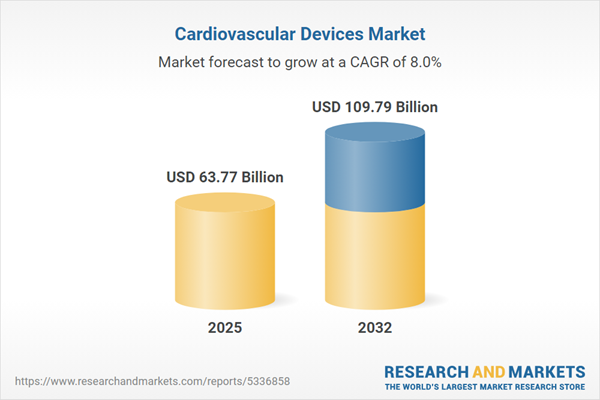Speak directly to the analyst to clarify any post sales queries you may have.
The cardiovascular devices market is undergoing transformative change as regulatory, technological, and demographic trends converge to shape new growth trajectories and operational realities for sector leaders. Forward-thinking senior executives will benefit from clear, actionable insights grounded in current trends and future-facing opportunities.
Market Snapshot: Cardiovascular Devices Sector Growth and Trends
The Cardiovascular Devices Market grew from USD 59.21 billion in 2024 to USD 63.77 billion in 2025. It is expected to continue growing at a CAGR of 8.02%, reaching USD 109.79 billion by 2032. This growth reflects shifting investment priorities, evolving regulatory requirements, and the acceleration of digital health solutions that are fundamentally changing how care is delivered and managed.
Scope & Segmentation: Critical Landscape for Senior Leaders
- Device Type: Diagnostic & monitoring devices (ECG systems, electrode leads, accessories, event monitors, Holter monitors, implantable loop recorders); surgical devices (cardiac stents, catheters, heart valves, vascular grafts); and therapeutic devices (blood pressure monitors, defibrillators, pacemakers).
- Operation Type: Invasive devices and non-invasive devices encompass both traditional and emerging procedural approaches.
- Access Type: Transcutaneous and transvenous access methods distinguish patient comfort considerations and technical requirements.
- Application: Cardiac rhythm management, coronary artery disease, peripheral vascular disease, and stroke management represent the primary clinical categories addressed by device innovation.
- End User: Ambulatory surgical centers, home care settings, and hospitals and clinics are the main points of care adoption and impact.
- Regional Coverage: The report analyzes substantial growth and adoption patterns across:
- Americas
- Europe, Middle East & Africa
- Asia-Pacific
- Key Companies: Insights cover strategic moves and innovation from organizations such as Abbott Laboratories, Boston Scientific Corporation, Medtronic PLC, Siemens Healthineers, and Johnson & Johnson Services, Inc., among others.
Enabling Technologies and Regional Dynamics
- Technologies: Integration of artificial intelligence in diagnostics, advanced biomaterials in device manufacturing, and digital health connectivity are priorities shaping investment and R&D pipelines.
- Regional trends: While North America and Western Europe emphasize rapid adoption and regulatory compliance, Asia-Pacific markets are focusing on expanding domestic manufacturing and leveraging strategic international alliances.
Key Takeaways: Strategic Imperatives and Competitive Differentiators
- Regulatory bodies now prioritize real-world evidence and lifecycle management, prompting manufacturers to enhance data collection, surveillance, and proactive regulatory engagement.
- Value-based care models are driving device companies to build strong evidence of patient outcomes and cost efficiencies, shifting strategic focus from one-time product approval to sustained value demonstration.
- Technological innovation in remote monitoring and minimally invasive solutions is pushing investment into digital health integration and next-generation device design.
- Leading firms increasingly leverage outcome-based contracting and vertical integration to unlock recurring revenue streams and improve supply chain resilience.
- Diversifying supplier bases and localizing manufacturing are critical responses to supply chain volatility and changing trade policies, particularly in the wake of new tariff introductions in key markets.
Tariff Impact on Supply Chains and Pricing Strategies
The United States’ introduction of tariffs in 2025 has forced device manufacturers to re-examine sourcing and pricing. Companies are adapting by restructuring supplier partnerships, increasing domestic production, and renegotiating terms with procurement authorities to cushion cost pressures. These actions are expected to shape future pricing flexibility and supply chain agility.
Methodology & Data Sources: Robust, Transparent Insights
This report synthesizes primary interviews with sector executives, clinicians, regulators, and investors, supported by secondary research from peer-reviewed publications, regulatory filings, and market analysis. Cross-verification and scenario planning ensure all insights are credible and reflect the latest market realities.
Why This Report Matters: Actionable Intelligence for Decision-Makers
- Empowers executives to anticipate market shifts, regulatory changes, and technology adoption patterns to inform strategic planning.
- Enhances operational agility by revealing concrete approaches to supply chain management, product development, and risk mitigation.
- Equips market leaders with the best-practice guidance needed to capture emerging growth opportunities and optimize stakeholder value.
Conclusion
Senior leaders in the cardiovascular devices sector can utilize this report to navigate operational risks, prioritize new opportunities, and align innovation strategy with evolving market needs and stakeholder expectations.
Additional Product Information:
- Purchase of this report includes 1 year online access with quarterly updates.
- This report can be updated on request. Please contact our Customer Experience team using the Ask a Question widget on our website.
Table of Contents
3. Executive Summary
4. Market Overview
7. Cumulative Impact of Artificial Intelligence 2025
Companies Mentioned
The companies profiled in this Cardiovascular Devices market report include:- Abbott Laboratories
- ACS Diagnostics
- Alivecor, Inc.
- Asahi Kasei Corporation
- B. Braun SE
- Baxter International Inc.
- Bexen Medical
- Biotronik SE & Co KG
- Boston Scientific Corporation
- BPL Medical Technologies Private Limited
- Edwards Lifesciences Corporation
- GE Healthcare
- HeartFlow Holding, Inc.
- Johnson & Johnson Services, Inc.
- Koninklijke Philips N.V.,
- Lepu Medical Technology(Beijing)Co.,Ltd.
- LivaNova PLC
- Medtronic PLC
- Microport Scientific Corporation
- Nihon Kohden Corporation
- Schiller AG
- Siemens Healthineers
- Terumo Cardiovascular Systems Corporation
- Tricog Health
- Vesalius Cardiovascular Inc.
- Zoll Medical Corporation
Table Information
| Report Attribute | Details |
|---|---|
| No. of Pages | 182 |
| Published | November 2025 |
| Forecast Period | 2025 - 2032 |
| Estimated Market Value ( USD | $ 63.77 Billion |
| Forecasted Market Value ( USD | $ 109.79 Billion |
| Compound Annual Growth Rate | 8.0% |
| Regions Covered | Global |
| No. of Companies Mentioned | 27 |









